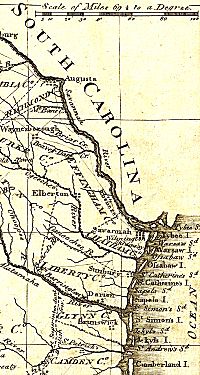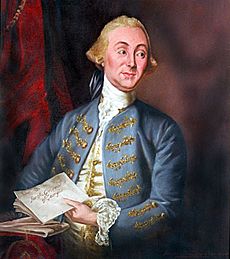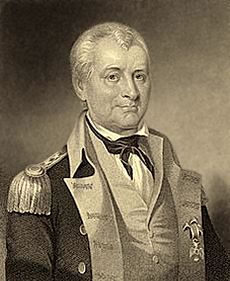Battle of the Rice Boats facts for kids
Quick facts for kids Battle of the Rice Boats |
|||||||
|---|---|---|---|---|---|---|---|
| Part of the American Revolutionary War | |||||||
 A 1796 map showing the Savannah area, Hutchinson Island is in the Savannah River near the town. |
|||||||
|
|||||||
| Belligerents | |||||||
| Commanders and leaders | |||||||
| Lachlan McIntosh | Andrew Barclay James Grant |
||||||
| Strength | |||||||
| Land: 800 militia 3 artillery pieces 1 shore battery Sea: 1 fire ship unknown supply ships |
Land: 250–300 infantry Sea: 4 men-of-war 2 transports |
||||||
| Casualties and losses | |||||||
| 1 wounded 1 fire ship sunk 3 supply ships captured |
Unknown ~2 men-of-war damaged 3 supply ships sunk |
||||||
The Battle of the Rice Boats, also known as the Battle of Yamacraw Bluff, was a fight during the American Revolutionary War. It happened on March 2 and 3, 1776, near the Savannah River in Georgia and South Carolina. In this battle, American Patriot soldiers and sailors fought against a small fleet from the Royal Navy (British navy).
In late 1775, the British Army was surrounded in Boston. They needed food and supplies. So, the Royal Navy sent ships to Georgia to buy rice and other goods. When these ships arrived, American rebels in Georgia took control of the government. They arrested the British Royal Governor, James Wright. The rebels also tried to stop the British from taking supply ships that were docked in Savannah. Some of these supply ships were burned to keep them from the British. Others were taken back by the Americans. But most of the ships were successfully captured by the British.
Governor Wright later escaped and reached one of the British ships. His escape meant that Britain no longer controlled Georgia. However, British rule returned briefly when Savannah was captured again in 1778. Governor Wright ruled from 1779 to 1782. British troops finally left Georgia when the war ended.
Contents
Why Did the Battle of the Rice Boats Happen?
Rising Tensions in the Colonies
In April 1775, disagreements over British rules in the Thirteen Colonies led to war. This started with the Battles of Lexington and Concord. After these battles, American Patriots surrounded Boston. This was called the Siege of Boston. The city could still get supplies by sea. News of these events, and the Battle of Bunker Hill in June, made more colonists want independence.
Georgia had tried to stay neutral. But by the summer of 1775, radical Patriots took power in Georgia's government. They slowly took away the powers of Georgia's Royal Governor, James Wright. Governor Wright had asked for British navy ships to be sent to Savannah. But Patriots in Charleston, South Carolina secretly changed his request. They sent a message saying he did not need naval support.
British Ships Arrive for Supplies
The situation in Georgia became critical in January 1776. British warships began arriving at Tybee Island. By January 18, several ships were there, including HMS Cherokee and HMS Siren. Governor Wright believed these ships were sent to punish the rebels. However, these ships were actually part of a larger fleet. This fleet was sent to get food and supplies for the British troops stuck in Boston.
General William Howe had ordered this mission in December 1775. By early February, the entire fleet was off Tybee Island. Captain Andrew Barclay was in charge. The fleet included HMS Scarborough and two transport ships. These transports carried about 200 British soldiers from the 40th Foot under Major James Grant.

Governor Wright's Arrest and Escape
When the first British ships arrived in January, Georgia's Committee of Safety acted. They ordered the arrest of Governor Wright and other British officials on January 18. Joseph Habersham, a major in the Georgia militia, put Governor Wright under house arrest. Wright promised not to contact the British ships.
But Wright felt unsafe and feared for his life. He escaped his home on the night of February 11. He went to a Loyalist (someone loyal to Britain) supporter's plantation. From there, he was taken to the British ship Scarborough. Meanwhile, Georgia's assembly met. They chose representatives for the Second Continental Congress. They also started forming regiments for the Continental Army.
After Governor Wright reached Scarborough, he wrote a letter. He was frustrated because the Patriots would not guarantee his safety or allow access to supplies. Georgia, like other colonies, had agreed in 1774 to stop trading with Great Britain. This agreement was called the Continental Association. Since talks failed, Captain Barclay ordered his fleet to act on February 29. His goal was to get the merchant ships docked at Savannah. Their owners wanted to move their goods, which became possible on March 1.
What Happened During the Battle?
British Advance on Savannah
On March 1, several British ships, including Scarborough and Tamar, sailed up the Savannah River. They went to a spot called Five-Fathom Hole. They were with transport ships carrying 200 to 300 soldiers under Major Grant. One British ship, Hinchinbrook, tried to get above the town. But it got stuck on a sandbank in the river.
Militia led by Joseph Habersham fired at Hinchinbrook, clearing its decks. But Habersham's men could not capture the ship. It floated free when the tide came in. Late on the night of March 2, Major Grant's soldiers landed on Hutchinson Island. They crossed the island quietly. At 4:00 am on March 3, they took over several rice boats anchored near the island. The alarm was not raised in Savannah until 9:00 am.
When the British ships arrived on March 1, the Committee of Safety called for the town's defense. They also asked South Carolina for help.
Fighting at Yamacraw Bluff
When the alarm sounded, Colonel Lachlan McIntosh took 300 militiamen. They set up three cannons on Yamacraw Bluff. He sent Lieutenant Daniel Roberts and Major Raymond Demeré II to one of the captured ships. They went under a white flag, meaning they wanted to talk. But they were immediately arrested.
A second, larger group went to discuss releasing the captives and ships. But Captain Rogers, their leader, was insulted. He fired at someone on the British ship. The British fired back, wounding one American and almost sinking their boat. After the American boat retreated, Colonel McIntosh fired his cannons from the bluff. A gun battle began, lasting four hours.

Burning the Rice Boats
The Committee of Safety decided to burn the supply ships. A group of militia was gathered to do this. One supply ship, Inverness, was set on fire. It was then sent drifting towards the British-occupied ships. This caused a panic among the British troops. They quickly abandoned the ships as the fire ship approached.
During this confusion, the Patriot militia and cannons kept firing. They shot at the British crews with muskets and grape shot. Two of the occupied ships managed to escape downstream. Two more escaped the flames by going upstream. But they were forced to dock, and their crews were captured. Three ships were destroyed by the fire, which burned late into the night. About 500 South Carolina militia arrived, helping the Americans.
What Happened After the Battle?
Colonel McIntosh sent a message to Captain Barclay the next day. He offered to exchange prisoners. When Barclay refused, the Committee of Safety ordered the arrest of the remaining members of Governor Wright's council. This worked. The British released the American prisoners in exchange for promises to protect the council members.
Despite the fighting, the British successfully sailed most of the merchant ships down the Back River. Some ships had to dump part of their cargo to get through the shallow water. Once they reached Tybee Island, the British loaded 1,600 barrels of rice onto their two transport ships.
The British fleet stayed anchored off Tybee Island while prisoner exchange talks continued. During this time, the fleet stopped several arriving ships. These ships were later claimed as prizes (captured goods). On March 25, militia from Savannah burned all the houses on Tybee Island. This was to prevent Governor Wright and the British officers from using them.
Captain Barclay left Tybee Island on March 30. He sailed north with the merchant ships and transports. The British had already left Boston earlier in March. So, Barclay first went to Newport, Rhode Island. But the local Patriots there refused to help him. They even fired at his ships with cannons. He eventually joined the British forces in Halifax, Nova Scotia in May.
The Battle of the Rice Boats and Governor Wright's departure ended British control over Georgia. This lasted until Savannah was recaptured by British forces in December 1778. Governor Wright returned, and Savannah remained in British hands until 1782.

